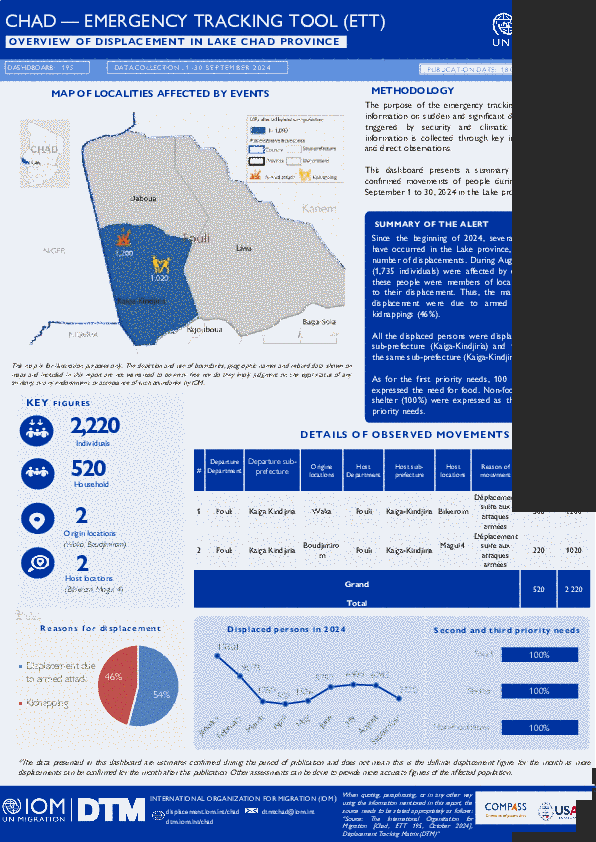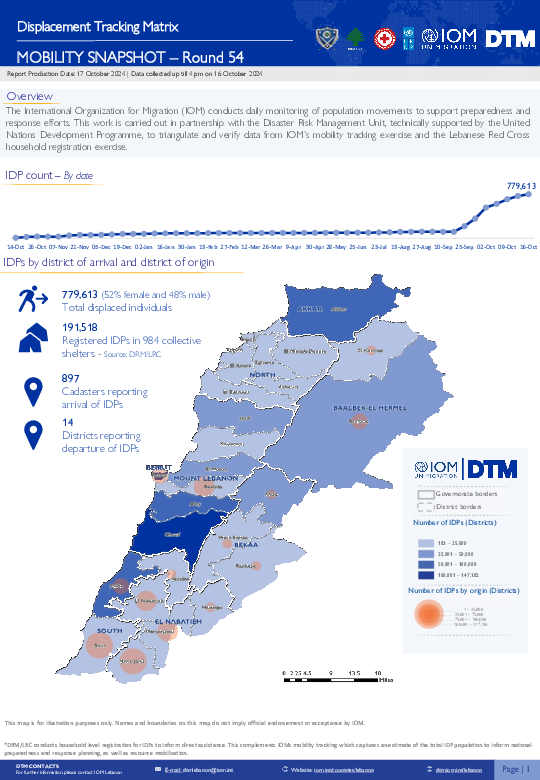-
Countries
-
Data and Analysis
-
Special Focus
-
Crisis Responses
Mobility Tracking

Contact
dtmhaiti@iom.int
Language
English
Location
Haiti
Period Covered
Oct 18 2024
Oct 19 2024
Activity
- Mobility Tracking
- Event Tracking
This information was collected following the armed attacks that have occurred since 17 October 2024 in the bordering areas of the municipalities of Port-au-Prince and Delmas on the one hand, particularly in the neighborhoods of Solino and Cité Numéro 2 and on the other hand in the municipality of Tabarre, precisely in the neighborhood of Tabarre 27. A total of 4,201 people were displaced following these attacks, including 3,487 following the attacks in Port-au-Prince and Delmas and 714 following those in Tabarre. The majority of people (61%), or 2,565 people, took refuge in sites, including 6 sites that already existed before these incidents and 3 sites newly created following these incidents. The rest of the people (39%) took refuge with host families.

Contact
DTM Chad, dtmtchad@iom.int
Language
English
Location
Chad
Period Covered
Sep 01 2024
Sep 30 2024
Activity
- Mobility Tracking
- Event Tracking
The purpose of the emergency tracking tool is to collect information on sudden and significant displacements mainly triggered by security and climatic emergencies. The information is collected through key informant interviews and direct observations.
This dashboard presents a summary of information on confirmed movements of people during the period from September 1 to 30, 2024 in the Lake province.

Contact
IraqDTM@iom.int
Language
English
Location
Iraq
Period Covered
Apr 01 2024
Aug 15 2024
Activity
- Mobility Tracking
- Event Tracking
In January 2024, the Iraqi Council of Ministers announced the closure of the remaining 23 IDP camps in the Kurdistan Region of Iraq by the end of July 2024. The International Organization for Migration’s (IOM) Displacement Tracking Matrix (DTM) in Iraq launched a tracking tool in April 2024.
This Movement of Camp IDPs report presents bi-weekly updates on the number of families leaving the camps and their main characteristics.

Contact
IraqDTM@iom.int
Language
English
Location
Iraq
Period Covered
Apr 01 2024
Aug 01 2024
Activity
- Mobility Tracking
- Event Tracking
In January 2024, the Iraqi Council of Ministers announced the closure of the remaining 23 IDP camps in the Kurdistan Region of Iraq by the end of July 2024. The International Organization for Migration’s (IOM) Displacement Tracking Matrix (DTM) in Iraq launched a tracking tool in April 2024.
This Movement of Camp IDPs report presents bi-weekly updates on the number of families leaving the camps and their main characteristics.

Contact
DTM DRC, iomdrcdtm@iom.int
Language
French
Location
Democratic Republic of the Congo
Period Covered
Jul 11 2024
Aug 09 2024
Activity
- Mobility Tracking
- Baseline Assessment
Ce tableau de bord présente les principaux résultats de suivi des mouvements de populations dans la province du Tanganyika à l’issue du douzième round d’évaluation conduit par l’unité de la Matrice de Suivi des Déplacements (Displacement Tracking Matrix, en anglais (DTM)) de l’Organisation Internationale pour les Migrations (OIM). Ces évaluations ont été réalisées à travers un exercice de collecte de données conduit du 11 juillet au 9 août 2024, en collaboration avec l’ONG locale, Promotion de Développement Humain et Protection de l’Environnement Social (PDHPES), et la Division Provinciale des Affaires Humanitaires (DIVAH). Lors de ce cycle, un total de 5 483 villages, couvrant 11 zones de santé (ZS), ont été évalués à travers des consultations avec 15 625 informateurs clé.

Contact
DTM DRC, iomdrcdtm@iom.int
Language
English
Location
Democratic Republic of the Congo
Period Covered
Jul 08 2024
Aug 16 2024
Activity
- Mobility Tracking
- Baseline Assessment
Ce tableau de bord présente les principaux résultats de suivi des mouvements de populations dans la province du Sud-Kivu à l’issue du treizième round d’évaluation conduit par l’unité de la Matrice de Suivi des Déplacements (Displacement Tracking Matrix, en anglais (DTM)) de l’Organisation Internationale pour les Migrations (OIM). Ces évaluations ont été réalisées à travers un exercice de collecte de données conduit du 8 juillet au 16 août 2024, en collaboration avec l’ONG locale, Réseau d’Action pour le Développement et le Progrès Intégré (RADPI) et la Division Provinciale des Affaires Humanitaires (DIVAH). Lors de ce cycle, un total de 5 734 villages, couvrant 34 zones de santé (ZS), ont été évalués à travers des consultations avec 17 435 informateurs clé.

Contact
DTM DRC, iomdrcdtm@iom.int
Language
French
Location
Democratic Republic of the Congo
Period Covered
Jul 13 2024
Aug 20 2024
Activity
- Mobility Tracking
- Baseline Assessment
Ce tableau de bord présente les principaux résultats de suivi des mouvements de populations dans la province du Nord-Kivu à l’issue du onzième round d’évaluation conduit par l’unité de la Matrice de Suivi des Déplacements (Displacement Tracking Matrix, en anglais (DTM)) de l’Organisation Internationale pour les Migrations (OIM). Ces évaluations ont été réalisées à travers un exercice de collecte de données conduit du 13 juillet au 20 août 2024, en collaboration avec l’ONG locale, Promotion de Développement Humain et Protection de l’Environnement Social (PDHPES), et la Division Provinciale des Affaires Humanitaires (DIVAH) du Nord-Kivu. Lors de ce cycle, un total de 6 302 villages, couvrant 34 zones de santé (ZS), ont été évalués à travers des consultations avec 18 881 informateurs clé.

Contact
DTM DRC, iomdrcdtm@iom.int
Language
French
Location
Democratic Republic of the Congo
Period Covered
Jul 14 2024
Aug 22 2024
Activity
- Mobility Tracking
- Baseline Assessment
Ce tableau de bord présente les principaux résultats de suivi des mouvements de populations dans la province de l’Ituri à l’issue du douzième round d’évaluation conduit par l’unité de la Matrice de Suivi des Déplacements (Displacement Tracking Matrix, en anglais (DTM)) de l’Organisation Internationale pour les Migrations (OIM). Ces évaluations ont été réalisées à travers un exercice de collecte de données conduit du 14 juillet au 22 août 2024, en collaboration avec l’ONG locale, Réseau d’Action pour le Développement et le Progrès Intégré (RADPI), et la Commission Nationale pour les Réfugiés (CNR). Lors de ce cycle, un total de 6 732 villages, couvrant 38 zones de santé (ZS), ont été évalués à travers des consultations avec 17 713 informateurs clés.
Contact
dtmlebanon@iom.int
Location
Lebanon
Activity
- Mobility Tracking
- Baseline Assessment
Period Covered
Oct 10 2023 -Oct 13 2024
Since October 8 there has been an increase in cross-border incidents between Israel and Lebanon, resulting in the displacement of people both within the South and elsewhere within the country. Since October 10, the Displacement Tracking Matrix (DTM) has been conducting the daily monitoring of population movements. The objective of the exercise is to inform preparedness and response planning.
To get access kindly click on the 'Request Access' button
Population Groups
IDPs
Survey Methodology
Unit of Analysis Or Observation
Admin Area 2
Household
Individual
Type of Survey or Assessment
Key Informant
Keywords
Geographical Scope Full Coverage
Administrative boundaries with available data
The current dataset covers the following administrative boundaries

Contact
dtmlebanon@iom.int
Language
English
Location
Lebanon
Period Covered
Oct 10 2023
Oct 16 2024
Activity
- Mobility Tracking
- Baseline Assessment
Since October 8 there has been an increase in cross-border incidents between Israel and Lebanon, resulting in the displacement of people both within the South and elsewhere within the country. Since October 10, the Displacement Tracking Matrix (DTM) has been conducting the daily monitoring of population movements. The objective of the exercise is to inform preparedness and response planning.
Pagination
- Previous page
- Page 13
- Next page
